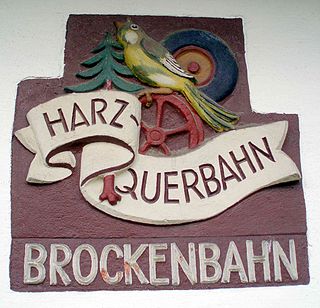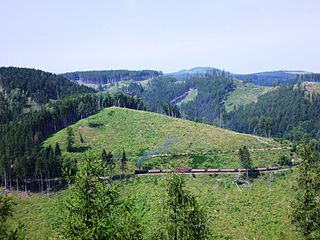
The Selke Valley Railway (Selketalbahn), Gernrode-Harzgerode Railway and the Anhalt Harz Railway were different names for the metre gauge railway in the Lower Harz, Germany, originally owned by the Gernrode-Harzgerode Railway Company.

Güntersberge is a village and a former town in Harz District, in Saxony-Anhalt, Germany. It holds the status of an officially recognized resort town since 2001. Güntersberge, together with the other municipalities of the former Verwaltungsgemeinschaft Unterharz, merged into the town of Harzgerode as of 1 August 2009.

Schielo is a village and a former municipality in the district of Harz, Saxony-Anhalt, Germany. Since 1 August 2009, it is part of the town of Harzgerode. Basket weaving was common until in the early 20th century logging took over. Today agriculture, a number of small businesses, a caring home specialising in residential and nursing dementia care, as well as tourism related activities dominate the area.

Hasselfelde is a town in the district of Harz, in Saxony-Anhalt, Germany. It is situated in the eastern Harz, approximately 17 km south of Wernigerode. Since 1 January 2010, it is part of the town Oberharz am Brocken. As of 1 January 2010 Hasselfelde has 2,390 inhabitants.

Neudorf is a village and a former municipality in the district of Harz, in Saxony-Anhalt, Germany. Since 1 September 2010, it is part of the town Harzgerode.

The Nordhausen-Wernigerode Railway Company or NWE was the second railway company to be founded in the Harz mountains in Germany, after the Gernrode-Harzgerode Railway Company. On 15 June 1896 the NWE was formed by the Vereinigten Eisenbahnbau- und Betriebs-Gesellschaft in Berlin, who also ran its operations. As early as 1896 the first section of this narrow gauge Harz Railway ('Harzquerbahn') was opened, followed by the Brocken Railway (Brockenbahnin) 1898, which was also narrow gauge. On 1 April 1908, the NWE took over operations from the Vereinigten Eisenbahnbau- und Betriebsgesellschaft.

Anhalt Castle is a ruined medieval fortification near the town of Harzgerode in Saxony-Anhalt, Germany.

Falkenstein Castle, also formerly called New Falkenstein Castle to distinguish it from Old Falkenstein Castle, is a German hill castle in the Harz Mittelgebirge, dating to the High Middle Ages. It is located in the town of Falkenstein between Aschersleben and Harzgerode.

Trautenstein is a village in the borough of Oberharz am Brocken in the district of Harz in the German state of Saxony-Anhalt. Trautenstein has 493 inhabitants (1-1-2010).

Meisdorf House is a schloss in the village of Meisdorf in the borough of Falkenstein in the German federal state of Saxony-Anhalt, that is now used as a hotel. It was built in 1708 with a 12-hectare (30-acre) castle park.

Mägdesprung is a village in the municipality of Harzgerode in the district of Harz. It nestles in the Harz Mountains at a height of 295 m.

The Bremen Hut in the Harz Mountains is a refuge hut and shelter in that part of the Harz National Park lying within the borough of Ilsenburg (Harz) in Harz district in the German state of Saxony-Anhalt.

The Ackeburg, also called the Ackenburg, in the Harz Mountains of central Germany, is the site of a high medieval hill castle, 333.2 m above sea level (NN), in the borough of Falkenstein/Harz in Harz district in the state of Saxony-Anhalt. It was first mentioned in 1216 and was abandoned or destroyed in 1400. There was also a village associated with it, known as Akkeburg.

The Kapitelsberg in the Harz Mountains of Germany is a hill, 535.7 m above sea level (NN), near the village of Tanne in the county of Harz, Saxony-Anhalt.

The Elversstein in the Harz Mountains of Germany is a granite rock formation with a maximum elevation of 499 m above sea level (NN) on the Steinberg near Hasserode in the county of Harz in Saxony-Anhalt.
The Drei-Länder-Stein is a boundary stone at the tripoint of the German federal states of Lower Saxony, Saxony-Anhalt and Thuringia near the Großer Ehrenberg mountain in the Harz.

The Bergrat Müller Pond, named after a former mining director, Müller, in the Harz mountains of central Germany is a storage pond laid out from 1737 to 1738. It has an area of about 1.3 ha and lies in the forested southern part of the borough of Quedlinburg in the county of Harz in Saxony-Anhalt.

The Scharfenstein is a 462.4 m above sea level (NN) high hill spur of the Eichberg-Süd in the Harz Mountains of Germany, near the town of Wernigerode in the county of Harz in Saxony-Anhalt.



































